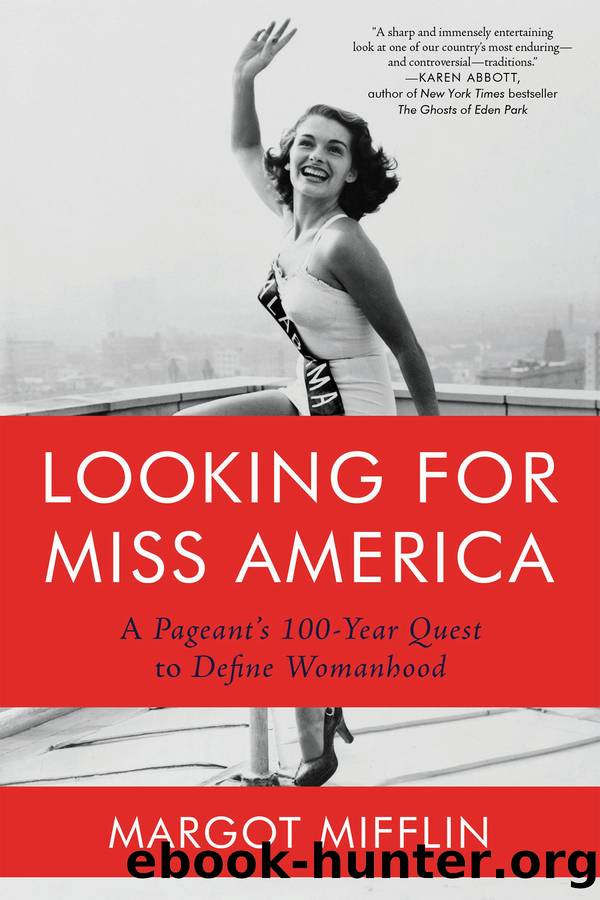Looking for Miss America by Margot Mifflin

Author:Margot Mifflin
Language: eng
Format: epub
ISBN: 9781640092242
Publisher: Counterpoint
Published: 2020-05-21T00:00:00+00:00
EVEN AS ITS STAR WAS dimming in the 1970s, the pageant was progressing, quietly, in a few ways. During her 1972 reign, Laurel Lea Schaefer became a spokesperson for families of missing veterans and POWs, anticipating the social issues platform that became an entry requirement in 1990. In 1974, the pageant added a modest scholarship for women pursuing careers in medicine. The interview questions got tougher on current events, though they were asked behind closed doors. Women were introduced by their college affiliations. The robe was retired, the roses scrapped. (“We’re eliminating the robe to tell America we are not crowning Queen Elizabeth in the middle of the eighteenth century,” Marks told the 1974 contestants, scrambling his history and forgetting . . . the crown?)
The ceremony still struck chords of obliviousness, notably a 1974 production number called “A Good Year” (never mind that Nixon had just resigned in disgrace after months of impeachment proceedings). But it was also finally on a path to diversity. In 1968, of 70,000 women entering state pageants, forty to fifty were black; now the numbers were inching up and more women of color were placing in them. With Lenora Slaughter as her witness, an African American beauty made it to Atlantic City in 1970. She was Cheryl Browne, Miss Iowa, a state where 1 percent of the population was black.
Browne was actually from Queens, New York, attending Luther College in Decorah, Iowa, where she won the campus title that led her to the state crown. And she was as New York as Junior’s cheesecake. Her mother was a hospital clinic manager in Queens, her father a narcotics officer at Kennedy Airport. She had attended Manhattan’s High School of Performing Arts and had been a freelance fashion model. She was extroverted, with a natural smile and a careful but game approach to the media. “I know all the reporters want me to say something controversial,” she said. “But I’m going to fool them. I’m not going to.” That said, she was up front about being a Democrat who supported the women’s movement (but didn’t grasp its opposition to Miss America). She had marched on campus in support of starting a black studies program. (“I’m not a militant,” she said. “I fall somewhere in between the Urban League and the Black Panthers.”) She hoped her win would “show the radicals in the black power movement that things aren’t so bad.” She opposed the Vietnam war, though unlike Miss Montana Kathy Huppe, she wasn’t censored for saying so.
Browne was confident about nearly everything, it appeared, except her unequivocally good looks. She was at pains, in an Iowa Public Television interview, to say she didn’t believe she was beautiful. Her comments could be dismissed as mere boilerplate about how Miss America isn’t really a beauty contest, but for a historical coincidence that invites a double take: the publication, that year, of Toni Morrison’s harrowing first novel, The Bluest Eye, about a black child who wishes for blue eyes so she can be as pretty as a white girl.
Download
This site does not store any files on its server. We only index and link to content provided by other sites. Please contact the content providers to delete copyright contents if any and email us, we'll remove relevant links or contents immediately.
| Civilization & Culture | Expeditions & Discoveries |
| Jewish | Maritime History & Piracy |
| Religious | Slavery & Emancipation |
| Women in History |
Cecilia; Or, Memoirs of an Heiress — Volume 1 by Fanny Burney(31322)
Cecilia; Or, Memoirs of an Heiress — Volume 3 by Fanny Burney(30928)
Cecilia; Or, Memoirs of an Heiress — Volume 2 by Fanny Burney(30885)
The Secret History by Donna Tartt(16606)
Sapiens: A Brief History of Humankind by Yuval Noah Harari(13036)
Leonardo da Vinci by Walter Isaacson(11894)
The Radium Girls by Kate Moore(10901)
Sapiens by Yuval Noah Harari(4528)
The Wind in My Hair by Masih Alinejad(4420)
How Democracies Die by Steven Levitsky & Daniel Ziblatt(4392)
Homo Deus: A Brief History of Tomorrow by Yuval Noah Harari(4272)
Endurance: Shackleton's Incredible Voyage by Alfred Lansing(3834)
The Silk Roads by Peter Frankopan(3751)
Man's Search for Meaning by Viktor Frankl(3621)
Millionaire: The Philanderer, Gambler, and Duelist Who Invented Modern Finance by Janet Gleeson(3565)
The Rape of Nanking by Iris Chang(3507)
Hitler in Los Angeles by Steven J. Ross(3431)
The Motorcycle Diaries by Ernesto Che Guevara(3325)
Joan of Arc by Mary Gordon(3253)
